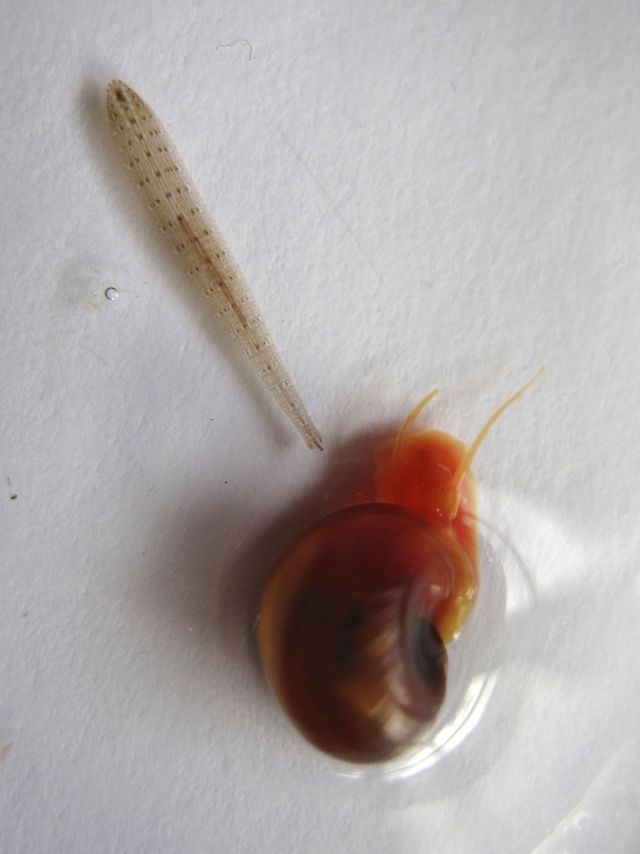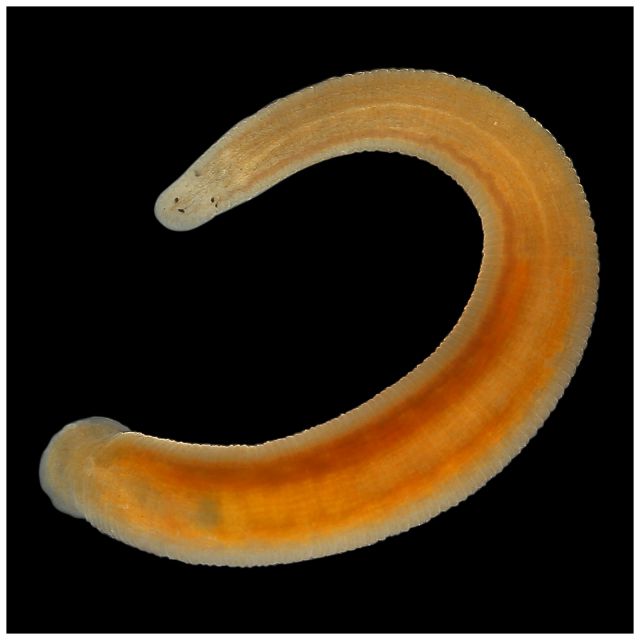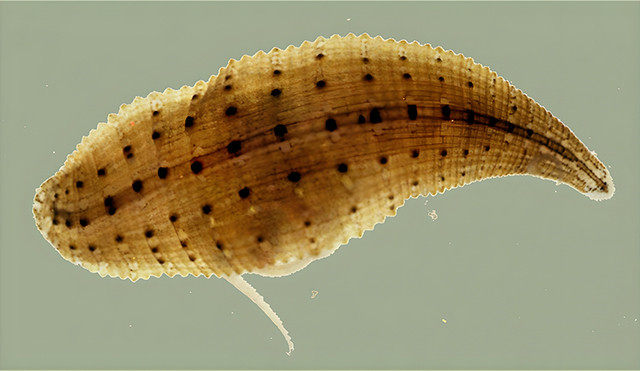Source and copyright of the header picture: Prof. Dr. Ulrich Kutschera - Own image via Wiki Commons, license: CC BY-SA 3.0. Picture is edited (more sharpness, frame removed).
The so-called accompanying fauna, which can appear in the aquarium, may include, among other things, leeches. Although, in principle, leeches feed predatory, not all species pose a threat to your aquarium inhabitants. Therefore, they are not necessarily to be considered a pest. In this article, we give you assistance in the identification and handling of aquatic leeches.
Introduction of leeches
Not unlike other small beasties (planarian flatworms, hydra), leeches can end up in your tank alongside privately traded, submerse aquatic plants. Other paths like pre-owned aquarium equipment, decoration and substrate are possible, too. Since some leech species such as glossiphonia sp. (the snail-leech) are also native to Europe, an introduction through live food from ponds is possible, too. Snails in particular are a very popular “free ride”.
Control methods
To minimize the risk of introducing leeches - but also other unwanted accompanying fauna - into your aquarium, it is best to go for in vitro plants. These plants are cultivated, stored and sold under completely sterile conditions and are therefore free from any critters, algae and foreign plants.
Another option would be to quarantine newly acquired aquarium plants and animals (refer : "preparing plants for your shrimp tank"). Pre-owned technology and decoration should be disinfected before use.
Types of leeches
In the following, we introduce some species of leech that can occasionally pop up in an aquarium. Matching this, you will get tips on identification and control methods for a leech infestation of your aquarium.
Snail-leeches

Copyright by Roland Emmenlauer.
Snail-leeches usually belong to the species Glossiphonia. The most common species are native to Germany and partly found in waters: the great snail-leech (Glossiphonia complanata) and the small snail-leech (Glossiphonia heteroclita). Insofar, caution is advised, when catching live-food from open waters.
Snail-leeches can be pretty easily identified by their build - which is drop-shaped. Often, eggs and the digestive tract can be seen in the middle of the body, which makes them easily distinguishable from planarian flatworms.
From species to species, snail-leeches vary in colour, reddish-brown, green and also creamy-white colours are possible. They can reach a length of up to three centimeters. Mostly they live hidden in the substrate or holding onto stones or plant leaves.
Snail-leeches live predatory off worms and snails, which are unceremoniously sucked dry. These leeches are unsurprisingly VERY unwelcome guests in aquariums containing more special snails like Tylomelania sp. Fortunately, they do not occur in larger groups, but are more likely to pop up as individuals.
The movement of the snail-leech resembles that of a caterpillar. First, the rear end is held on the ground by a suction cup, then the leech pushes its front end forward. Next, the suction cup at the front end attaches to the ground and the tail end follows. This mode of movement is quite different from planarians and other aquatic worms. Furthermore, snail-leeches are skillful swimmers - much unlike planatian flatworms -, moving surprisingly fast through the water in s-shapes. A snail-leech’s body doesn’t feel soft and slimy, but hard and gristly.
Control methods
Since snail-leeches don’t usually show up in large numbers, you can easily collect or suck away animals discovered in the aquarium. Natural predators are unfortunately unknown. Typical worm-killers like Panacur or Flubenol do not work against snail-leeches. Although preparations that contain copper are toxic to them, unfortunately those will also finish off other invertebrates such as crabs, shrimp and snails.
Asian freshwater leech

Barbronia weberi is among the Rhynchobdellida. Originating from Asia, this leech spread in Europe, Australia and America. The specimens in our aquariums were certainly first introduced to our homes in Germany with aquarium plants from Asian garden centers. Barbronia weberi has been firmly established in aquaristics. Of course, Asian leeches can still be brought in from Asia with aquatic plants. If you discover a brown-red, relatively slender leech in your aquarium, it is most likely a member of this species. It can reach a length of about 4 cm. When taking a closer look, it is noticeable, that Barbronia weberi has a thicker tail-end and a rather narrow head - depending on its level of stretchiness its body shape can vary quite drastically. The leech has three pairs of eyes, one in the middle and two more pairs on the left and right side of its head. This eye placement is characteristic for Barbronia weberi, thus a good photo of its head is enough for classification. Due to its appearance, this leech is well-distinguishable from planarian flatworms, but most of all by its locomotion: Similar to an inchworm, the leech makes steps as it progresses with the help of the suction cups at its front and rear end. Planarian flatworms and many other worms move in a more sliding manner. Furthermore, the Asian leech is a skillful and agile swimmer who wriggles through the water - planarians, on the other hand, can not swim at all.
Even though Barbronia weberi is a predatory leech, small worms and ground-dwelling microorganisms are on its menu. There is no danger for your fish, shrimp and snails.
Control methods
Barbronia weberi shouldn’t be seen as a large threat, since it’s a welcome live-food for many fish. A colonization of your tank in large numbers is also a very rare thing. The easiest and most effective way to combat a leech infestation is by manually collecting or siphoning them off. Deworming agents like Panacur and Flubenol are useless against leeches. Preperations containing copper can kill Barbronia weberi but will also severely harm other invertebrates like snails and shrimp. So such a treatment is not recommended, depending on the individual inhabitants of the aquarium.
European flat leech

Copyright: Prof. Dr. Ulrich Kutschera - own image via Wiki Commons, license: CC BY-SA 3.0. Picture is edited (more sharpness, frame removed).
The name Helobdella europaea is a bit misleading. Most likely, the European flat leech is originally from South America. This leech, belonging to the Rhynchobdellida has spread all over the world. It has also settled in European waters, insofar an introduction into the aquarium by live food from ponds is possible. Originally, this leech was probably brought to Europe with imported aquatic plants. This species is capable of surviving in an aquarium.
These leeches are rather small with a length of one to two centimeters and have only one pair of eyes. Very striking is its dotted pattern on the back with light to reddish body color. Other features are typical: a teardrop-shaped physique and a caterpillar-like locomotion by means of suction cups. The leeches care intensively for their brood, meaning that the mother carries the eggs and larvae for several weeks.
The European flat leech preys on other, smaller worms, snails and midge larvae. This leech seems to be harmless for aquarium fish, shrimp and snails might be considered potential prey, though.
Control methods
Similar to other leeches, the easiest way to get rid of them is to manually pick them off. Unfortunately, not much is known about other possible countermeasures. Just as with other leech species, deworming agents like Panacur and Flubenol won’t help, but preparations containing copper, will. As said before, these will also harm the miscellaneous invertebrates (shrimp, crabs and snails).